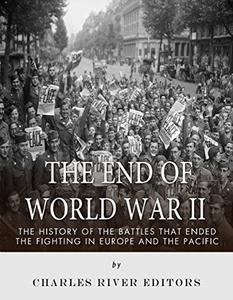The End of World War II The History of the Battles that Ended the Fighting in Europe and the Pacific

The End of World War II: The History of the Battles that Ended the Fighting in Europe and the Pacific by Charles River Editors
English | June 25, 2015 | ISBN: 1514693887 | 334 pages | EPUB | 11 Mb
*Includes pictures *Includes accounts of fighting at major battles like D-Day, Okinawa, Iwo Jima, the Bulge, and more *Includes online resources and a bibliography for further reading *Includes a table of contents During World War II, the free world literally hung in the balance, with the Axis and Allies engaging in warfare on an unprecedented scale. Although Hitler's Nazi Germany had overrun much of the European continent by 1940, the Allies began to reverse the momentum in 1942. By the end of 1943, with Allied forces firmly established in Italy and the Soviets on the verge of turning the tide in Russia, the British and Americans began to Description the invasion that would liberate Europe from the Nazis. After the successful amphibious invasion on D-Day in June 1944, the Allies began racing east toward Germany and liberating France along the way. The Allies had landed along a 50 mile stretch of French coast, and despite suffering 8,000 casualties on D-Day, over 100,000 still began the march across the western portion of the continent. By the end of August 1944, the German Army in France was shattered, with 200,000 killed or wounded and a further 200,000 captured. However, Adolf Hitler reacted to the news of invasion with glee, figuring it would give the Germans a chance to destroy the Allied armies that had water to their backs. As he put it, "The news couldn't be better. We have them where we can destroy them." After resisting the German attack at the Battle of the Bulge, the Allied armies began advancing, and with that, the race to Berlin was truly on. In the weeks it took for the Battle of Berlin to be fought, an American president passed away, a British Prime Minister had to make concessions he did not desire, a Russian leader fought his way into Western Europe to stay, and a German one took his own life. The battle's implications would be felt for the next 50 years. When Admiral Chester Nimitz was directed to capture an island in the Bonin group, Iwo Jima stood out for its importance in making progress against the mainland, with three airfields that would allow American air forces to attack the Japanese mainland. But the Japanese were also well aware of how important Iwo Jima was, and they fought desperately in bunkers and tunnels that required the Americans to carefully clear them out gradually. Near the end of 1944, as Allied forces were pushing across the Pacific and edging ever closer to Japan, plans were drawn up to invade the Ryuku islands, the most prominent of them being Okinawa. Military planners anticipated that an amphibious campaign would last a week, but instead of facing 60,000 Japanese defenders as estimated, there were closer to 120,000 on the island at the beginning of the campaign in April 1945. The Battle of Okinawa was the largest amphibious operation in the Pacific theater, and it would last nearly 3 months and wind up being the fiercest in the Pacific theater during the war, with nearly 60,000 American casualties and over 100,000 Japanese soldiers killed. In addition, the battle resulted in an estimated 40,000-150,000 Japanese civilian casualties. Given the horrific nature of the combat, and the fact that it was incessant for several weeks, it's no surprise that Okinawa had a profound psychological effect on the men who fought, but it also greatly influenced the thinking of military leaders who were planning subsequent campaigns, including a potential invasion of the Japanese mainland. The casualty tolls at Okinawa ultimately helped compel President Truman to use the atomic bombs on Hiroshima and Nagasaki in an effort to end the war before having to attempt such an invasion. The End of World War II: The History of the Battles that Ended the Fighting in Europe and the Pacific chronicles the background leading up to the end of the war in 1945. Along with pictures of important people, places, and events, you will learn about the end of World War II like never before.
Download From UploadCloud
https://www.uploadcloud.pro/7wbsyb20v7m1/jtq63.T.E.o.W.W.I.T.H.o.t.B.t.E.t.F.i.E.a.t.P.rar.html
Download From NovaFile
https://nfile.cc/WqPpaB9q/jtq63.T.E.o.W.W.I.T.H.o.t.B.t.E.t.F.i.E.a.t.P.rar
![]()
https://rapidgator.net/file/87855687325099896aa12380bad3f9d2/jtq63.T.E.o.W.W.I.T.H.o.t.B.t.E.t.F.i.E.a.t.P.rar.html
![]()
https://nitroflare.com/view/C62F7CED0E1A6B5/jtq63.T.E.o.W.W.I.T.H.o.t.B.t.E.t.F.i.E.a.t.P.rar
![]()
https://uploadgig.com/file/download/5a678467739c7f5E/jtq63.T.E.o.W.W.I.T.H.o.t.B.t.E.t.F.i.E.a.t.P.rar
https://www.uploadcloud.pro/7wbsyb20v7m1/jtq63.T.E.o.W.W.I.T.H.o.t.B.t.E.t.F.i.E.a.t.P.rar.html
Download From NovaFile
https://nfile.cc/WqPpaB9q/jtq63.T.E.o.W.W.I.T.H.o.t.B.t.E.t.F.i.E.a.t.P.rar

https://rapidgator.net/file/87855687325099896aa12380bad3f9d2/jtq63.T.E.o.W.W.I.T.H.o.t.B.t.E.t.F.i.E.a.t.P.rar.html

https://nitroflare.com/view/C62F7CED0E1A6B5/jtq63.T.E.o.W.W.I.T.H.o.t.B.t.E.t.F.i.E.a.t.P.rar

https://uploadgig.com/file/download/5a678467739c7f5E/jtq63.T.E.o.W.W.I.T.H.o.t.B.t.E.t.F.i.E.a.t.P.rar
Please Help Me Click Connect Icon Below Here and Share News to Social Network | Thanks you !
Significant surge in the popularity of free ebook download platforms. These virtual repositories offer an unparalleled range, covering genres that span from classic literature to contemporary non-fiction, and everything in between. Enthusiasts of reading can easily indulge in their passion by accessing free books download online services, which provide instant access to a wealth of knowledge and stories without the physical constraints of space or the financial burden of purchasing hardcover editions.


Comments (0)
Users of Guests are not allowed to comment this publication.